| |
發行人:林恭如所長 編輯委員:吳肇欣教授 主編:林筱文 發行日期:2017.09.30 |
| |
|
 |
|
 本所教師榮膺IEEE Photonics Journal編輯群(林恭如教授—資深編輯、黃升龍教授—副編輯、林晃巖教授—副編輯),特此恭賀!
本所教師榮膺IEEE Photonics Journal編輯群(林恭如教授—資深編輯、黃升龍教授—副編輯、林晃巖教授—副編輯),特此恭賀!
 本所博士生魏子喬同學榮獲「106年度臺大科林論文獎—博士論文頭等獎」(林恭如教授指導),特此恭賀!
本所博士生魏子喬同學榮獲「106年度臺大科林論文獎—博士論文頭等獎」(林恭如教授指導),特此恭賀!
 本所碩士生楊皓麟同學參加研討會IDMC (International Display Manufacturing Conference)與IEDMS (International Electron Devices & Materials Symposium 2017),榮獲「Best Paper Award」(陳奕君教授指導),特此恭賀!
本所碩士生楊皓麟同學參加研討會IDMC (International Display Manufacturing Conference)與IEDMS (International Electron Devices & Materials Symposium 2017),榮獲「Best Paper Award」(陳奕君教授指導),特此恭賀!
本所10月份演講公告:
|
日期
|
講者簡介 |
講題 |
地點 |
時間 |
|
光電所專題演講 |
|
10/20
(Fri) |
曾宗琳 先生
前台積電財務長 |
科技人的企業財務管理知識和個人理財觀 |
電機二館
145 教室 |
14:20~16:00 |
|
10/27
(Fri) |
賴聰賢教授
國立中興大學電機系與光電所 |
Photonic Molecule:
Optical-coupled microcavities embedded with
quantum dots |
博理館
101演講廳 |
14:20~16:00 |
|
10/27
(Fri) |
Prof.
David S. Citrin
Electrical and Computer
Engineering, Georgia Institute of
Technology |
待訂 |
博理館
101演講廳 |
16:00~17:30 |
|
|
 |
|
 |
|
| |
|
 |
|
~ 光電所106年暑期大學生光電營 花絮報導 ~
(時間:106年7月25日至27日;地點:臺灣大學博理館
)
花絮整理:所學會會長蔡瑞祥、活動總召黃智偉
臺大光電所除了專注在研究領域、關心同學的身心健康外,也很注重想來就讀的學弟妹們,因此每年暑假都會舉辦為期三天、從早到晚、包吃包車包上課的精采營隊—臺大光電營!這個活動是專門為大學部三、四年級的同學舉辦,旨在向學弟妹們介紹光電領域相關的知識,並介紹所上目前發展的概況,也提供申請方面的資訊,對於學弟妹來說是個非常好的機會與體驗!
第一天上午先由林恭如所長為我們開啟光電營的序幕,簡單介紹光電科技的背景後,接著下午則分別由李志昌博士、Dr.
Sandeep Chakraborty、黃升龍教授以及李翔傑教授介紹關於生醫光電技術及其產業,豐富的內容讓大家對生醫光電有了更深入的了解。
第二天一早則是先參觀實驗室,我們前往電機一館參觀光電實驗室,學長姐十分用心地讓我們看見全像術的應用,將科技結合生動活潑的影片,促進學習的欲望與研究的動力。參觀完實驗室後,緊接著是由黃建璋教授為我們帶來固態照明技術及其產業的演講,以及陳奕君教授帶來的太陽能電池技術與產業的演講,精彩的演講讓大家獲益良多,台下的學生也很踴躍的發問,就在良好的一問一答下進入午餐時間。下午則是由IEEE的講者Prof.
Kent Choquette帶來演講「Vertical
Cavity Laser Arrays Present Status and
Future Prospects」,長達兩個小時的演講,卻一點也不乏悶,大家都非常專注聆聽。最後由蔡政庭博士的光通訊及其產業的演講作為第二天的尾聲。
第三天則是業界參訪,早上先前往新竹的啟碁科技,除了參觀他們的一些產業外,也請了畢業於臺大的學長來為我們說明介紹工作內容,以及一些求職技巧。下午前往位於台中后里的美光科技,特別感謝美光科技提供的員工餐,用餐完畢後,美光也安排了畢業於臺大的學長為我們詳細介紹,有趣的演講內容讓大家印象深刻,透過業界參訪,讓大家著實了解光電科系畢業後的發展,以及未來趨勢。至此,為期三天的光電營也告一段落,最後感謝所有學弟妹的參與,以及所辦的安排,也謝謝所學會的成員這一年的幫忙,105所學會下台一鞠躬。
|
|
|
|
|
|
|
|
 |
|
 |
|
| |
|
 |
A 3D electrode design for fast-response VA-FFS liquid crystal mode
Professor Wing-Kit Choi
Graduate Institute of Photonics and
Optoelectronics, National Taiwan University
臺灣大學光電所 蔡永傑教授
In this work, a 3D electrode design is proposed [1] for a Vertically-Aligned Fringe-Field Switching (VA-FFS or Dual-FFS) liquid crystal mode which is known for its intrinsic sub-millisecond fast response time without using thin cell gap or other liquid crystal phases. Compared to the previously proposed 2D electrode designs [2-3], we found that, by using this new 3D electrode design, it is possible to improve the potential maximum transmission due to reduced disclination lines or deadzones (without using a double-sided electrode structure) and also to improve the potential response speed due to smaller effective domain size of liquid crystals. A major mechanism for causing such a fast response time is due to the formation of self-imposed boundaries [3] (or so-called virtual walls) which can be viewed as liquid crystals having very small “effective” cell gap. This proposed approach of achieving fast response time in liquid crystals can be very attractive since it doesn’t require more complicated liquid crystal phases (or materials) such as Blue Phase or SmC* Ferroelectrics. This approach may simply use standard nematic liquid crystal phase or materials such as E7. Moreover, this approach doesn’t require the use of very thin cell gap (e.g. 2μm or below) which is less practical for large area fabrication. This proposed technique of achieving fast response time in liquid crystals can therefore be attractive for the future development of fast response liquid crystal displays, intensity or phase modulators.
[1] Wing-Kit Choi, Chia-Hsiang Tung and Bo-Kai Tseng, “Fast Response VA-FFS Liquid Crystal Mode using 3D electrode design”, SID 2017 Digest, pp.1838-1840, May 2017
[2] M. Jiao, Z. Ge, S. T. Wu, and W. K. Choi, “Sub-millisecond response liquid crystal modulators using dual field switching in a vertically aligned cell,” Appl. Phys. Lett., 92, 111101, Mar. 2008
[3] W.K. Choi & S.T. Wu, “Fast response liquid crystal mode,” US Patent 7298445 B1, Nov. 2007
|

|
|
Fig. 1 shows electrode design and molecular orientation of 2D VA-FFS (left) and the new 3D VA-FFS (right) at voltage-on state. |
|
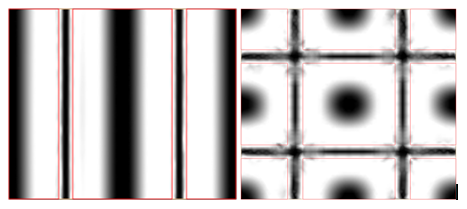
|
|
Fig. 2 shows the top-view
transmission of 2D VA-FFS (left) and 3D VA-FFS
(right). The figure on the right shows that
disclination lines (or deadzones) are indeed
reduced along the transverse (or y)
direction in the 3D VA-FFS. |
|
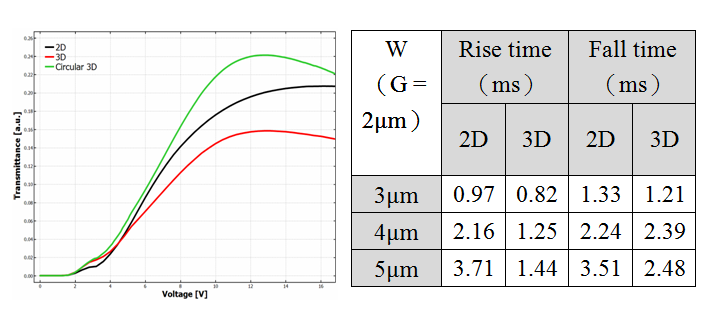
|
|
Fig. 3 shows the improvement of the transmission (figure on left, with circular polarizer) and also improvement of response speed (Table on right) of 3D VA-FFS compared to 2D VA-FFS liquid crystal mode. |
Threshold Voltage Improvement Through Sidewall Control of InGaAs Fin-structured High Electron Mobility Transistors (Fin-HEMTs)
Professor Chao-Hsin Wu’s laboratory
Graduate Institute of Photonics and
Optoelectronics, National Taiwan University
臺灣大學光電所 吳肇欣教授
The fabrication process was started with fin formation by inductively coupled plasma dry etch. The source and drain metal were deposited by e-beam evaporator and followed by rapid thermal annealing to form Ohmic contacts. Then, the recess region was etched by diluted sulfuric acid followed by self-aligned gate metal of Ni/Au. Fin widths were finally defined by recess etch and varied from 396 to 54 nm. The schematic cross section and structure are shown in Fig. 1.
Figure 2 shows ID-VG characteristics of FinHEMTs with different fin widths (Wfin). Threshold voltage (VT) shifts toward positive direction from -1.41 V to 0.56 V as Wfin decreases. It can be observed that compared to planar devices, VT of Fin-HEMT moves to +VG as Wfin decreases. As Wfin is reduced down to about 90 nm, the device starts to work at enhancement mode operation. The mechanism is proposed in Fig.3. When VG decreases from VG1 (large) to VG2 (smaller), top gate still cannot turn off the channel. So the planar devices are still at on-state operation. On the other hand, for fin-shaped devices, though top gate is not capable of turning off the channel, the depletion region from surface of sidewalls is large enough to fully deplete the channel.
|
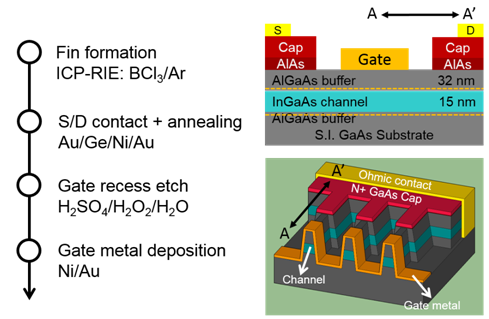
|
|
Fig. 1. Process flow, schematic cross section and
device structure of InGaAs Fin-HEMT |
|
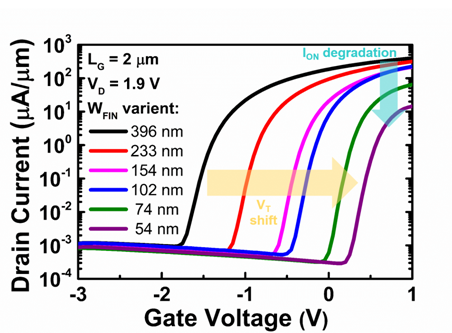
|
|
Fig. 2. Transfer characteristics of InGaAs FinHEMTs
with different fin width at VD = 1.9 V |
|
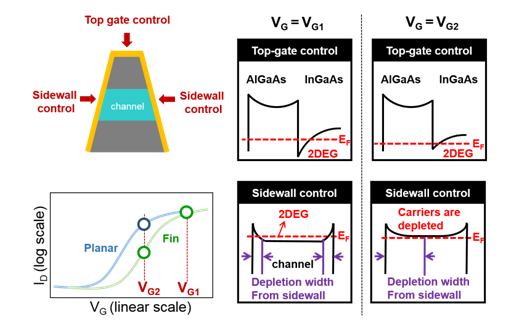
|
|
Fig. 3. Schematic mechanism of top gate and sidewall
gates proposed in this work |
 |
| |
|
|
|
 |
|
| |
|
 |
論文題目:硒化鎘/硫化鋅膠狀量子點光穩定性及其應用於微碟共振腔雷射之研究
姓名:鄭智怡 指導教授:毛明華教授
| 摘要 |
|
在本論文中,我們製作具三明治結構的二氧化矽埋覆膠狀量子點微碟共振腔雷射(SiO2 sandwiched colloidal CdSe/ZnS quantum-dot microdisk lasers)。三明治結構除了可以保護膠狀量子點減緩氧化,也可增加量子點主動層發光與共振腔光場的重合。我們製作各種不同尺寸的微碟共振腔雷射,皆可於室溫下以連續波操作,其中直徑為10微米的微碟,其雷射閾值約為500 kW/cm2,品質因子可達1900。為了進一步提升膠狀量子點的光穩定性,我們以原子層沉積技術成長厚度僅10奈米的氧化鋁薄膜將膠狀量子點包覆保護,研究結果顯示出以原子層沉積的氧化鋁薄膜能大幅提升膠狀量子點在空氣中的光穩定性,對於膠狀量子點發光元件的應用上非常重要。最後我們將此技術整合至元件中,成功使膠狀量子點微碟雷射在空氣中穩定操作並且提升微碟雷射之元件特性。
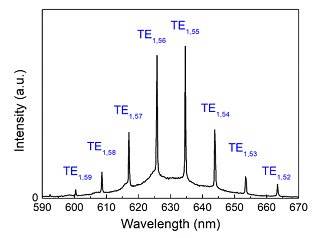 |
|
圖一、直徑10微米的二氧化矽埋覆膠狀量子點微碟共振腔雷射之模態頻譜 |
|
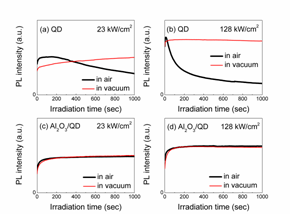 |
|
圖二、有無氧化鋁薄膜保護之量子點於真空及空氣中發光強度隨時間的變化 |
|
|
|
 |
|
 |
|
| |
|
 |
—
資料提供:影像顯示科技知識平台 (DTKP, Display Technology
Knowledge Platform) —
—
整理:林晃巖教授、王子聖 —
類視網膜之單畫素相機
受到人眼視網膜結構的啟發,蘇格蘭的科學家在單畫素相機系統開發中已經設法規避了速度和解析度之間常見的折衷。
單畫素成像是透過將一系列連續的不同二進制圖案,應用於要被成像的場景的光路上,並且測量在單個光電檢測器上同步記錄的數據之相關性來進行工作的。然而,在這樣的系統中,由於測量的數量等於最終影像中的重建像素的數量,所以在解析度和幀率之間會存在固有的折衷。
Miles Padgett、David Phillips和他在英國格拉斯哥大學(the University of Glasgow)的同事目前已經展示了一種方法,透過採用具有類似於人眼視網膜的空間變化解析度,而非具有統一解析度的二進制模式來克服這個限制。特別地,圖形遮罩(見圖一)具有被周圍較低解析度包圍的高解析中央凹狀區域。該方法的好處是它可以在感興趣的區域(見圖二)中進行更高解析的成像,而不會為了要達到高解析度所需的水準,將整個區域成像的幀率放慢。Padgett的團隊報告了局部幀率的增強為4倍。此外,「中心凹」區域的位置可以隨意改變,允許使用物件追踪或多個中央凹狀高解析區域的機會。
 |
|
圖一、空間變化解析度之畫素網格,也包含了N = 1024個畫素的變化區域。在中央凹狀處,畫素遵循笛卡爾網格,即三個維度兩兩正交的直角網格。周圍的中央凹狀是周邊圓柱極化系統的畫素。 |
|
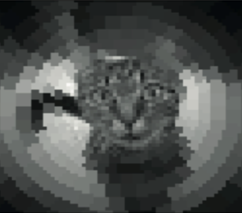 |
|
圖二、實驗的成像結果 |
單畫素成像基於場景與一系列圖形之間的相關性程度的測量。這些圖形可以被投影到場景上,或可以透過一種稱為結構化檢測的技術用來被動地屏蔽場景的影像,以及他們現在所提出的方法。在這項工作中使用的單像素相機的示意圖如圖三所示。數位微鏡裝置(DMD)被放置在相機鏡頭的影像平面上,利用一組二進制圖形,來快速掩蔽場景中的影像,並且透過光電二極體記錄由每個遮罩所發射的光的總量,其代表了每個遮罩與場景之相關性的測量。對發射強度的知識和相應的遮罩可以重建影像。
|
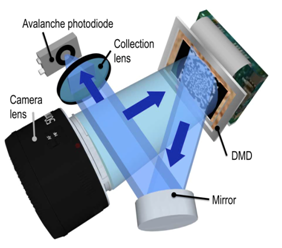 |
|
圖三、系統的架構。場景被泛光照射並成像到作為動態遮罩的DMD上,來自微鏡子集的光被反射到雪崩式光電二極體(APD),其記錄了由每個二進制遮罩圖形所傳輸的總強度。 |
Padgett表示為了要能夠在不同的解析度之間切換,他們正在一個使用不同尺度的圖形系統上進行合作。Dave採用的想法就好比人眼一樣在中央部份負責高解析度,外部則負責低解析度。他們認為這樣做對於所有單畫素相機或類似系統都是有益的。例如,他們已經將最近的飛行時間系統(time-of-flight)轉換為使用相同的方法。
格拉斯哥研究群所開發的系統使用白色LED手電筒作為照明源,與具有32×32個可程式像素之計算機控制的數位微鏡器件,來創造一個在被雪崩光電二極體(APD)檢測之前應用於場景圖像的動態二進制遮罩。研究團隊除了在可見光波長下進行操作外,還表示該方法同樣適用於其他波長方案。考慮到這一點,他們還展示了一種操作在800至1800奈米波長區域的短波紅外(short-wave infrared,
SWIR )單畫素成像系統。該系統通過使用SWIR敏感檢測器代替APD,並使用加熱燈作為照明源。
他們表示該方法的可能潛在應用包括機器視覺和氣體感測。
|
參考資料: |
1. Oliver Graydon, Retina-like single-pixel camera, Natural Photonics 11, 335 (2017)
DOI: 10.1038/nphoton.2017.87
http://www.nature.com/nphoton/journal/v11/n6/full/nphoton.2017.87.html
2. D. B. Phillips et al., Adaptive foveated single-pixel imaging with dynamic supersampling, Sci. Adv. 3 (4), e1601782 (2017)
DOI:10.1126/sciadv.1601782
|
| |
|
|
|
|
|
|
|
|
|
 |
|
 |
|
|
|
 |
|
 |
|